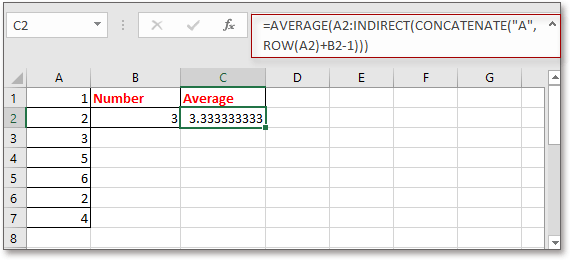Πώς να ορίσετε εύρος βάσει άλλης τιμής κελιού στο Excel;
Ο υπολογισμός ενός εύρους τιμών είναι εύκολος για τους περισσότερους χρήστες του Excel, αλλά έχετε προσπαθήσει ποτέ να υπολογίσετε ένα εύρος τιμών με βάση τον αριθμό σε ένα συγκεκριμένο κελί; Για παράδειγμα, υπάρχει μια στήλη τιμών στη στήλη Α και θέλω να υπολογίσω τον αριθμό τιμών στη στήλη Α με βάση την τιμή στο B2, πράγμα που σημαίνει ότι εάν είναι 4 στο B2, θα μετρήσω τις πρώτες 4 τιμές στο εμφανίζεται η στήλη Α όπως φαίνεται παρακάτω. Τώρα εισάγω μια απλή φόρμουλα για γρήγορο καθορισμό εύρους με βάση μια άλλη τιμή κελιού στο Excel.
Ορίστε εύρος με βάση την τιμή κελιού
 Ορίστε εύρος με βάση την τιμή κελιού
Ορίστε εύρος με βάση την τιμή κελιού
Για να κάνετε υπολογισμό για ένα εύρος βάσει άλλης τιμής κελιού, μπορείτε να χρησιμοποιήσετε έναν απλό τύπο.
Επιλέξτε ένα κενό κελί που θα βγάλετε το αποτέλεσμα, εισαγάγετε αυτόν τον τύπο = ΜΕΣΟΣ (Α1: ΑΜΕΣΑ (ΣΥΜΠΕΡΙΦΟΡΑ ("A", B2))), και πατήστε εισάγετε κλειδί για να λάβετε το αποτέλεσμα.
1. Στον τύπο, το Α1 είναι το πρώτο κελί στη στήλη που θέλετε να υπολογίσετε, το Α είναι η στήλη για την οποία υπολογίζετε, το Β2 είναι το κελί στο οποίο υπολογίζετε. Μπορείτε να αλλάξετε αυτές τις αναφορές όπως χρειάζεστε.
2. Εάν θέλετε να κάνετε περίληψη, μπορείτε να χρησιμοποιήσετε αυτόν τον τύπο = Άθροισμα (A1: ΑΜΕΣΗ (ΣΥΜΠΕΡΙΦΟΡΑ ("A", B2))).
3. Εάν τα πρώτα δεδομένα που θέλετε να ορίσετε δεν βρίσκονται στην πρώτη σειρά στο Excel, για παράδειγμα, στο κελί A2, μπορείτε να χρησιμοποιήσετε τον τύπο ως εξής: = ΜΕΣΟΣ (Α2: ΑΜΕΣΑ (ΣΥΜΠΕΡΙΦΟΡΑ ("A", ROW (A2) + B2-1))).
Μετρήστε γρήγορα / αθροίστε κελιά ανά χρώμα φόντου ή μορφής στο Excel |
| Σε ορισμένες περιπτώσεις, μπορεί να έχετε μια σειρά κελιών με πολλά χρώματα και αυτό που θέλετε είναι να μετρήσετε / αθροίσετε τιμές με βάση το ίδιο χρώμα, πώς μπορείτε να υπολογίσετε γρήγορα; Με Kutools για Excel's Μετρήστε ανά χρώμα, μπορείτε να κάνετε γρήγορα πολλούς υπολογισμούς ανά χρώμα και επίσης να δημιουργήσετε μια αναφορά για το υπολογισμένο αποτέλεσμα. Κάντε κλικ για δωρεάν πλήρη δοκιμαστική έκδοση σε 30 ημέρες! |
 |
| Kutools για Excel: με περισσότερα από 300 εύχρηστα πρόσθετα Excel, δωρεάν δοκιμή χωρίς περιορισμό σε 30 ημέρες. |
Τα καλύτερα εργαλεία παραγωγικότητας γραφείου
Αυξήστε τις δεξιότητές σας στο Excel με τα Kutools για Excel και απολαύστε την αποτελεσματικότητα όπως ποτέ πριν. Το Kutools για Excel προσφέρει πάνω από 300 προηγμένες δυνατότητες για την ενίσχυση της παραγωγικότητας και την εξοικονόμηση χρόνου. Κάντε κλικ εδώ για να αποκτήσετε τη δυνατότητα που χρειάζεστε περισσότερο...

Το Office Tab φέρνει τη διεπαφή με καρτέλες στο Office και κάνει την εργασία σας πολύ πιο εύκολη
- Ενεργοποίηση επεξεργασίας και ανάγνωσης καρτελών σε Word, Excel, PowerPoint, Publisher, Access, Visio και Project.
- Ανοίξτε και δημιουργήστε πολλά έγγραφα σε νέες καρτέλες του ίδιου παραθύρου και όχι σε νέα παράθυρα.
- Αυξάνει την παραγωγικότητά σας κατά 50% και μειώνει εκατοντάδες κλικ του ποντικιού για εσάς κάθε μέρα!
